Reference management. Clean and simple.

How to structure a thesis
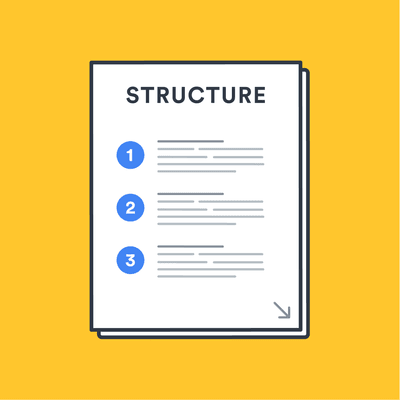
A typical thesis structure
1. abstract, 2. introduction, 3. literature review, 6. discussion, 7. conclusion, 8. reference list, frequently asked questions about structuring a thesis, related articles.
Starting a thesis can be daunting. There are so many questions in the beginning:
- How do you actually start your thesis?
- How do you structure it?
- What information should the individual chapters contain?
Each educational program has different demands on your thesis structure, which is why asking directly for the requirements of your program should be a first step. However, there is not much flexibility when it comes to structuring your thesis.
Abstract : a brief overview of your entire thesis.
Literature review : an evaluation of previous research on your topic that includes a discussion of gaps in the research and how your work may fill them.
Methods : outlines the methodology that you are using in your research.
Thesis : a large paper, or multi-chapter work, based on a topic relating to your field of study.
The abstract is the overview of your thesis and generally very short. This section should highlight the main contents of your thesis “at a glance” so that someone who is curious about your work can get the gist quickly. Take a look at our guide on how to write an abstract for more info.
Tip: Consider writing your abstract last, after you’ve written everything else.
The introduction to your thesis gives an overview of its basics or main points. It should answer the following questions:
- Why is the topic being studied?
- How is the topic being studied?
- What is being studied?
In answering the first question, you should know what your personal interest in this topic is and why it is relevant. Why does it matter?
To answer the "how", you should briefly explain how you are going to reach your research goal. Some prefer to answer that question in the methods chapter, but you can give a quick overview here.
And finally, you should explain "what" you are studying. You can also give background information here.
You should rewrite the introduction one last time when the writing is done to make sure it connects with your conclusion. Learn more about how to write a good thesis introduction in our thesis introduction guide .
A literature review is often part of the introduction, but it can be a separate section. It is an evaluation of previous research on the topic showing that there are gaps that your research will attempt to fill. A few tips for your literature review:
- Use a wide array of sources
- Show both sides of the coin
- Make sure to cover the classics in your field
- Present everything in a clear and structured manner
For more insights on lit reviews, take a look at our guide on how to write a literature review .
The methodology chapter outlines which methods you choose to gather data, how the data is analyzed and justifies why you chose that methodology . It shows how your choice of design and research methods is suited to answering your research question.
Make sure to also explain what the pitfalls of your approach are and how you have tried to mitigate them. Discussing where your study might come up short can give you more credibility, since it shows the reader that you are aware of its limitations.
Tip: Use graphs and tables, where appropriate, to visualize your results.
The results chapter outlines what you found out in relation to your research questions or hypotheses. It generally contains the facts of your research and does not include a lot of analysis, because that happens mostly in the discussion chapter.
Clearly visualize your results, using tables and graphs, especially when summarizing, and be consistent in your way of reporting. This means sticking to one format to help the reader evaluate and compare the data.
The discussion chapter includes your own analysis and interpretation of the data you gathered , comments on your results and explains what they mean. This is your opportunity to show that you have understood your findings and their significance.
Point out the limitations of your study, provide explanations for unexpected results, and note any questions that remain unanswered.
This is probably your most important chapter. This is where you highlight that your research objectives have been achieved. You can also reiterate any limitations to your study and make suggestions for future research.
Remember to check if you have really answered all your research questions and hypotheses in this chapter. Your thesis should be tied up nicely in the conclusion and show clearly what you did, what results you got, and what you learned. Discover how to write a good conclusion in our thesis conclusion guide .
At the end of your thesis, you’ll have to compile a list of references for everything you’ve cited above. Ideally, you should keep track of everything from the beginning. Otherwise, this could be a mammoth and pretty laborious task to do.
Consider using a reference manager like Paperpile to format and organize your citations. Paperpile allows you to organize and save your citations for later use and cite them in thousands of citation styles directly in Google Docs, Microsoft Word, or LaTeX:
🔲 Introduction
🔲 Literature review
🔲 Discussion
🔲 Conclusion
🔲 Reference list
The basic elements of a thesis are: Abstract, Introduction, Literature Review, Methods, Results, Discussion, Conclusion, and Reference List.
It's recommended to start a thesis by writing the literature review first. This way you learn more about the sources, before jumping to the discussion or any other element.
It's recommended to write the abstract of a thesis last, once everything else is done. This way you will be able to provide a complete overview of your work.
Usually, the discussion is the longest part of a thesis. In this part you are supposed to point out the limitations of your study, provide explanations for unexpected results, and note any questions that remain unanswered.
The order of the basic elements of a thesis are: 1. Abstract, 2. Introduction, 3. Literature Review, 4. Methods, 5. Results, 6. Discussion, 7. Conclusion, and 8. Reference List.
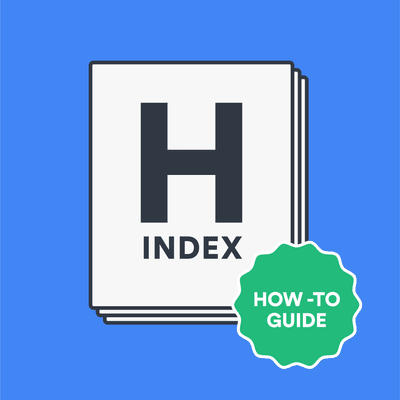
[email protected]
- English English Spanish German French Turkish

How to Structure a Thesis: A Complete Guide
Writing a thesis can be an overwhelming task for many college and graduate students. Managing all the elements associated with a thesis while ensuring that the quality is not compromised can be challenging. However, what is even more strenuous is deciding on a thesis's layout. "How to structure a thesis" is a question that several final-year students struggle to answer. And understandably so, as all colleges and universities have their guidelines for drafting a thesis. However, there is an immutable structure that's common for every thesis. In this brief guide, we will take a look at this structure and analyze each of its components.
This guide discusses how to structure a thesis effectively. To give you an opportunity to practice proofreading, we have left a few spelling, punctuation, or grammatical errors in the text. See if you can spot them! If you spot the errors correctly, you will be entitled to a 10% discount.
A thesis or dissertation is a long academic document that a master's or doctoral candidate writes to obtain a relevant academic degree. Hence, writing a quality thesis is crucial for college and university students. A good thesis demonstrates a student's academic prowess in their field of study as well as helps hone their analytical and research skills. Writing a thesis can be an overwhelming task for many college and graduate students. Managing all the elements associated with a thesis while ensuring that the quality is not compromised can be challenging. However, what is even more strenuous is deciding on a thesis's layout.
"How to structure a thesis" is a question that several final-year students struggle to answer. And understandably so, as all colleges and universities have their guidelines for drafting a thesis. However, there is an immutable structure that's common for every thesis. In this brief guide, we will take a look at this structure and analyze each of its components. If you are also struggling to initiate the writing process for your thesis, follow this guide and get over your writer’s block.
How to Structure a Thesis: Examining the Constituents of a Thesis Structure
Here we have a list of all major sections that a thesis structure generally comprises. The entire thesis structure is segregated into 3 sections, with each section comprising its relevant subsections to facilitate greater legibility.
Front/Preliminary Matter of a Thesis Structure
1. abstract.
An abstract is a concise summary of an entire thesis and consists of the condensation of your entire thesis. A good abstract is precise, concise (usually not more than 250 words) and emphasizes the importance of the document. When writing an abstract, make sure you explicitly mention the crux of your thesis. Also, avoid reiterating what you have mentioned in the title of your document.
Body of a Thesis Structure
2. introduction/preface.
The introduction chapter of your thesis outlines its core arguments, hypotheses, and results. It is longer than the abstract and contains adequate background information on your topic of interest. Furthermore, it establishes the relevance of your thesis by highlighting its contribution to the knowledge base of its topic. Writing a gripping introduction helps the readers understand the context of your thesis. According to USNSW Sydney, the introduction of a thesis should have the following stages:
State the general topic and give some background
Provide a review of the literature related to the thesis subject
Define the terms and scope of the thesis topic
Outline the existing situation
Evaluate the current situation and identify the gap in the literature
Identify the importance of the proposed research
State the main research questions
State the purpose of the study and/or research objectives
State the study hypotheses
Outline the order of information in the thesis
Outline the methodology.
3. Literature review
The literature review chapter sets the premise of your thesis. It examines and evaluates the research works that’s been conducted so far on your thesis topic and passively highlights the contributions of your thesis.
A literature review is a survey of academic sources on a specific subject, providing an overview of current knowledge, allowing you to discuss relevant theories, methods, and gaps in the existing research. Writing a literature review contains finding relevant publications, critically analyzing the sources, and explaining your findings in the literature. A well-written literature review doesn’t only summarize sources, it also aims to analyze, synthesize, and critically evaluate to give a clear picture of the state of knowledge on the topic.
To write an impeccable literature review, consult a plethora of sources and mention the canon related to your thesis topic. Also, put forward your review in a logical, chronological, and structured manner to better outline the knowledge gaps in your field of study and how your thesis will fill them.

The following simple and straightforward tips can act as the exhaustive rubric and offer meaningful insight to prospective authors on how to formulate a flawless literature review:
Step 1. Probe similar works for a well-structured literature review
Step 2. Analyze, not just synthesize: Authors should provide a detailed critique of the subject
Step 3. Organize your literature review systematically
Step 4. Establish the purview: Authors should specify the scope of the literature review
Step 5. Abstain from plagiarism
Step 6 . Be mindful of the language
4. Methodology
As the name suggests, the methodology section of a thesis consists of all methods and procedures you have used in your thesis. A well-written methodology accentuates the plausibility of your research methods. In addition, it enables your readers to understand why you chose specific methods and how they are justified for your research.
To garner more credibility, you can include the pitfalls and difficulties associated with your choice of research methods. The methodology section is an unavoidable part of a thesis or a research paper. Considering errors in the methodology section enervates the entire thesis.
Follow the steps below to write a perfect methodology for a thesis:
a. Give an outline of the research design
b. Don’t forget to define the philosophy behind the research
c. Mention the research approach
d. Introduce the research methods
e. Note the following points to highlight in the methodology. No matter what methodology you have chosen, you have to focus on the following points:
Explain sampling strategy.
Clearly state the procedure of the research paper.
Mention how you collect the data. (Data collection)
Explain how data are analyzed for your research. (Data analysis). Suppose you have written in qualitative strategy like thematic analysis, mention the researcher you have followed.
Mention the validity of the data and result.
Discuss all ethical aspects of your research paper.
f. Avail professional proofreading and editing services
g. Most important tips to compose an impactful methodology for a dissertation
Don’t drift from your objective and the purpose of your dissertation.
Explore scholarly research papers and their methodology sections to have a better idea.
Plan a proper writing structure.
Understand your audience and target group.
Don’t make mistakes in citing relevant sources. You may use APA and MLA citation
Refer to all the hurdles you have experienced while writing your dissertation.
Make sure to rectify grammatical and punctuation errors.
Ensure that the section is readable and doesn’t consist of long and complex sentences. Long sentences can hamper the tone of the methodology.
This section comprises the outcomes of your research work. It includes all the observations you made and the answers to all your hypotheses in the thesis. When writing the “results” chapter, include only factual data and format it to be distinguishable. Use tables, graphs, subheadings, and generic comments for the results. The aim is to enable your readers to discern the result of your research.
6. Discussion
The discussion chapter of your thesis should begin with a brief summarization of the outcome of your research work. It should explain how your results address your hypotheses and highlight any repetitions in your observations. You can also add comments on how you want the readers to interpret your results and about your agreements and disagreements with the available research work in your field.
Writing a flawless thesis requires much more than only subject matter expertise. It requires expertise, experience, and in-depth thinking, along with sharp intelligence. Though most students add a discussion chapter in their thesis or dissertation, many of them end up messing up the essay or missing out on the central issues.
A discussion chapter in a thesis is a place where you have the chance to delving into the analysis, importance, and relevance of your research. This section focuses on explaining and analyzing what you have researched, presenting how it is associated with the existing literature. It is also a place for argument supporting your entire discussion.
We often find that people seek thesis writing help from experienced editing and proofreading services to prepare a flawless discussion chapter. However, the following helpful tips can help you design a perfect master's or Ph.D.. thesis with an excellent discussion chapter:
Understand the objective of your thesis
Determine a clear structure
Usage of grammar and tense
Refer to hypotheses and literature review
Evaluate your results and compare them with existing studies
Understand the limitation of your research
Don’t be afraid to be unique
Don’t forget to avail a professional thesis editing and proofreading service
Click here to review the details of the aforementioned tips.
The following 5 questions might be helpful to write a sound discussion section:
How well do you understand the objective of your study?
What message is conveyed by your results?
How do your findings compare to findings in literature?
Why should your findings matter?
In what light should your findings be viewed?
7. Conclusion
The final section of your document consists of a precise answer to your hypothesis. In addition, the “conclusion” chapter of your thesis should stress the achievement of the aims of your thesis. You should also include certain limitations of your research to convey the fact that there is still scope for further research in your field.
The end matter of a thesis structure
The components of this section include an acknowledgment, a bibliography, and (occasionally) an appendix.
Parting words
The first step to writing a thesis is to chalk out its layout. Doing so not only helps you deal with the writing process one step at a time but also enables you to better attend to each component of a thesis structure.
Also, before you follow this thesis structure, make sure to check with your university for “how to structure a thesis” guidelines. If the guidelines offered by your institution deviate slightly from what’s mentioned in this guide, then make sure to prioritize the former.
If you need us to make your thesis shine, contact us unhesitatingly!
Best Edit & Proof expert editors and proofreaders focus on offering papers with proper tone, content, and style of academic writing, and also provide an upscale editing and proofreading service for you. If you consider our pieces of advice, you will witness a notable increase in the chance for your research manuscript to be accepted by the publishers. We work together as an academic writing style guide by bestowing subject-area editing and proofreading around several categorized writing styles. With the group of our expert editors, you will always find us all set to help you identify the tone and style that your manuscript needs to get a nod from the publishers.
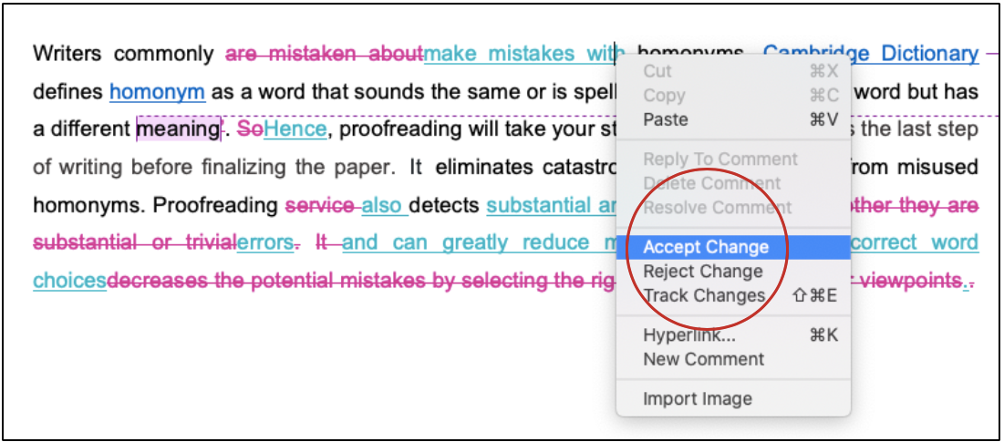
English formatting service for theses and dissertations
You can also avail of our assistance if you are looking for editors who can format your manuscript, or just check on the particular styles for the formatting task as per the guidelines provided to you, e.g., APA, MLA, or Chicago/Turabian styles. Best Edit & Proof editors and proofreaders provide all sorts of academic writing help, including editing and proofreading services, using our user-friendly website, and a streamlined ordering process.
Get a free quote for editing and proofreading now!
Visit our order page if you want our subject-area editors or language experts to work on your manuscript to improve its tone and style and give it a perfect academic tone and style through proper editing and proofreading. The process of submitting a paper is very easy and quick. Click here to find out how it works.
Our pricing is based on the type of service you avail of here, be it editing or proofreading. We charge on the basis of the word count of your manuscript that you submit for editing and proofreading and the turnaround time it takes to get it done. If you want to get an instant price quote for your project, copy and paste your document or enter your word count into our pricing calculator.

24/7 customer support | Live support
Contact us to get support with academic editing and proofreading. We have a 24/7 active live chat mode to offer you direct support along with qualified editors to refine and furbish your manuscript.

Stay tuned for updated information about editing and proofreading services!
Follow us on Twitter, LinkedIn, Facebook, Instagram, and Medium .
For more posts, click here.
- Editing & Proofreading
- Citation Styles
- Grammar Rules
- Academic Writing
- Proofreading
- Microsoft Tools
- Academic Publishing
- Dissertation & Thesis
- Researching
- Job & Research Application
Similar Posts
How to Determine Variability in a Dataset
How to Determine Central Tendency
How to Specify Study Variables in Research Papers?
Population vs Sample | Sampling Methods for a Dissertation
7 Issues to Avoid That may Dent the Quality of Thesis Writing
How to Ensure the Quality of Academic Writing in a Thesis and Dissertation?
How to Define Population and Sample in a Dissertation?
Recent Posts
ANOVA vs MANOVA: Which Method to Use in Dissertations?
They Also Read

Whether it is an academic essay or any other thesis paper, all the papers are directly or indirectly associated with one’s future. Therefore, making mistakes here means compromising with the future. However, students are fond of making some habitual errors while composing an academic paper. Let’s learn those mistakes and make sure not to repeat them in your turn.

Being a proofreading and editing service provider, we often find researchers making common citation mistakes in their research papers. Well, making mistakes is normal, but repeating the same mistakes is not accepted. Recognizing the gravity of the situation, we here bring the list of common errors students and researchers make while citing sources.

Whether you are new to academics or have been around for a while, you must understand that research is a critical segment of the academic field. Therefore, it is essential to know the WHATs, WHYs, and HOWs of it. Pertaining to that, this article discusses different types of research methods that you will come across. Namely, they are — quantitative research and qualitative research. Here, we will learn what these types of research are, how they are different, and when they are used. This will be especially helpful for researchers and students who are just starting with their research.

Being proficient in grammar takes years of practice and needs deep knowledge. Yet, you will still end up making grammatical mistakes, and that is understandable. However, when we are talking about academic writing, you need to be exceptionally careful that you do not end up making such mistakes. This article gives you 10 common grammatical mistakes in academic writing. If you are someone who tends to make such mistakes frequently, this article will be able to help you pinpoint those mistakes and fix them.

Who decides the layout requirements for a dissertation? The answer is primarily clear, either your supervisor or department. Nonetheless, each program has a standard guideline determining page numbers and table of contents. Should you use MLA or APA citation style, you follow the MLA format guide or APA guide. Here are 10 useful tips for dissertation layout and formatting.

A theoretical framework primarily supports the idea of a research study. It bears all the theories that prove the essence and importance of any research. In a nutshell, it is developed to explain the research and comprehend its circumstances. It may involve all the theory-based logic behind the importance and existence of your research in academics. This step-by-step guide discusses how to build a theoretical framework for a dissertation.

In statistics, a population refers to the pool of individuals from which one can draw the statistical sample for a study. A population includes a complete set of individuals. That group can comprise a nation or people sharing common characteristics.
- Privacy Policy

Home » Thesis – Outline, Structure and Writing Guide
Thesis – Outline, Structure and Writing Guide
- Table of Contents

A thesis is a substantial research document submitted as part of a degree program, typically at the master’s or doctoral level. It presents original research findings, explores a specific topic in depth, and contributes to the academic field. Writing a thesis requires thorough planning, a clear structure, and a methodical approach to present arguments and evidence effectively.
This guide explains the outline, structure, and step-by-step process for writing a thesis, offering tips to ensure academic success.
Thesis Outline
A thesis outline serves as a roadmap for organizing ideas, arguments, and evidence logically. It ensures consistency and coherence throughout the document. Below is a general outline for a thesis:
- Title of the thesis.
- Author’s name.
- Institutional affiliation.
- Submission date.
- A concise summary of the research, including objectives, methods, key findings, and conclusions.
- Express gratitude to individuals or organizations that supported the research.
- List of headings and subheadings with corresponding page numbers.
- Include all visual elements like charts, graphs, and tables with page numbers.
- Background of the study.
- Research problem or question.
- Objectives or hypotheses.
- Significance of the research.
- Overview of relevant theories and previous research.
- Identification of research gaps.
- Research design.
- Data collection and analysis methods.
- Ethical considerations.
- Presentation of data and key findings.
- Interpretation of findings.
- Comparison with existing literature.
- Implications of the study.
- Summary of findings.
- Limitations of the research.
- Recommendations for future studies.
- A complete list of all sources cited in the thesis.
- Supplementary material such as survey instruments, raw data, or detailed calculations.
Thesis Structure
1. title page.
The title page includes essential details about the thesis, such as the title, author’s name, program, supervisor, and submission date. Ensure compliance with your institution’s formatting guidelines.
2. Abstract
An abstract is a brief overview of the entire thesis, typically 150–300 words. It provides readers with a summary of the research question, methods, results, and significance.
3. Acknowledgments
Acknowledgments allow you to thank supervisors, colleagues, funding agencies, and others who contributed to your work.
4. Introduction
The introduction sets the stage for the research by explaining:
- Background: Contextualize the research topic.
- Research Problem: Define the problem your study addresses.
- Objectives: State what the research aims to achieve.
- Scope: Outline the boundaries of the research.
- Significance: Highlight the importance of the research for the academic field or practical applications.
5. Literature Review
This section provides a critical analysis of existing research related to the topic. It:
- Discusses key theories and studies.
- Identifies gaps or unresolved issues.
- Justifies the need for the current research.
6. Methodology
The methodology explains how the research was conducted, including:
- Design: Whether the study is qualitative, quantitative, or mixed-methods.
- Participants: Description of the sample or population.
- Data Collection: Methods used (e.g., surveys, interviews, experiments).
- Analysis: Techniques for analyzing data (e.g., statistical tests, thematic analysis).
This section presents the findings without interpretation. Use tables, charts, and graphs to display data clearly.
8. Discussion
The discussion interprets the findings in relation to the research questions and existing literature. Address:
- Patterns or Trends: Highlight significant results.
- Implications: Discuss how the findings contribute to theory or practice.
- Limitations: Acknowledge constraints or challenges faced.
9. Conclusion
Summarize the research, emphasizing its contributions and the significance of the findings. Suggest areas for future research.
10. References
List all sources cited, formatted according to the required citation style (e.g., APA, MLA, Chicago).
11. Appendices
Include supplementary material that supports the main text but is too detailed for inclusion in the main body.
Writing Guide for a Thesis
Step 1: choose a research topic.
- Select a topic that aligns with your interests and academic goals.
- Ensure the topic is specific, relevant, and feasible.
Step 2: Conduct a Literature Review
- Review existing studies to understand the research landscape.
- Identify gaps or unresolved questions.
Step 3: Define Research Objectives and Questions
- Clearly articulate what the study aims to achieve.
- Develop specific and measurable research questions or hypotheses.
Step 4: Develop a Research Plan
- Choose an appropriate methodology.
- Outline data collection and analysis procedures.
- Seek ethical approval if required.
Step 5: Draft the Thesis Outline
- Create a detailed outline based on the sections and sub-sections described earlier.
Step 6: Write the Thesis
- Start with the Introduction , providing context and stating the research objectives.
- Expand the Literature Review to critically discuss prior studies.
- Describe the Methodology with sufficient detail for replication.
- Present Results clearly using visual aids as needed.
- Interpret the results in the Discussion , relating them to the research objectives.
- Conclude the thesis by summarizing key findings and suggesting future directions.
Step 7: Edit and Revise
- Review the thesis for clarity, coherence, and accuracy.
- Ensure adherence to formatting and citation guidelines.
Step 8: Submit and Defend
- Submit the completed thesis for review.
- Prepare for the oral defense by anticipating questions and rehearsing answers.
Tips for Writing a Thesis
- Start Early: Allocate sufficient time for research, writing, and revisions.
- Stay Organized: Use tools like reference managers (e.g., Zotero, Mendeley) and project management apps.
- Seek Feedback: Share drafts with your advisor or peers for constructive feedback.
- Follow Guidelines: Adhere to institutional formatting and submission requirements.
- Stay Focused: Avoid tangential information that does not contribute to your research objectives.
Common Challenges and How to Overcome Them
- Procrastination: Set daily writing goals and deadlines to stay on track.
- Writer’s Block: Break tasks into smaller, manageable sections to build momentum.
- Data Overload: Focus on key findings that directly address the research questions.
- Time Management: Use a detailed timeline to balance research, writing, and personal commitments.
Example of a Thesis Outline
Title: The Impact of Social Media on Adolescent Mental Health
- Acknowledgments
- Background of Social Media Use
- Research Problem and Objectives
- Theories of Media Influence
- Existing Research on Adolescents and Mental Health
- Research Design (Quantitative Survey)
- Sample (High School Students)
- Data Collection Tools (Online Questionnaire)
- Statistical Analysis of Anxiety Levels and Screen Time
- Patterns of Social Media Usage
- Interpretation of Findings
- Implications for Education and Policy
- Study Limitations
A thesis represents a culmination of academic research and intellectual effort, showcasing a student’s ability to contribute to their field. By adhering to a clear outline, well-structured format, and methodical writing process, students can create a compelling and impactful thesis. With proper planning, time management, and attention to detail, writing a thesis becomes an achievable and rewarding academic milestone.
- Creswell, J. W. (2018). Research Design: Qualitative, Quantitative, and Mixed Methods Approaches . Sage Publications.
- Murray, R. (2011). How to Write a Thesis . Open University Press.
- Swales, J. M., & Feak, C. B. (2012). Academic Writing for Graduate Students . University of Michigan Press.
- American Psychological Association. (2020). Publication Manual of the American Psychological Association (7th ed.).
- Mauch, J. E., & Birch, J. W. (2010). Guide to the Successful Thesis and Dissertation . CRC Press.
About the author
Muhammad Hassan
Researcher, Academic Writer, Web developer
You may also like

Data Analysis – Process, Methods and Types

What is a Hypothesis – Types, Examples and...

Institutional Review Board – Application Sample...

Research Approach – Types Methods and Examples

Research Results Section – Writing Guide and...


Background of The Study – Examples and Writing...
While Sandel argues that pursuing perfection through genetic engineering would decrease our sense of humility, he claims that the sense of solidarity we would lose is also important.
This thesis summarizes several points in Sandel’s argument, but it does not make a claim about how we should understand his argument. A reader who read Sandel’s argument would not also need to read an essay based on this descriptive thesis.
Broad thesis (arguable, but difficult to support with evidence)
Michael Sandel’s arguments about genetic engineering do not take into consideration all the relevant issues.
This is an arguable claim because it would be possible to argue against it by saying that Michael Sandel’s arguments do take all of the relevant issues into consideration. But the claim is too broad. Because the thesis does not specify which “issues” it is focused on—or why it matters if they are considered—readers won’t know what the rest of the essay will argue, and the writer won’t know what to focus on. If there is a particular issue that Sandel does not address, then a more specific version of the thesis would include that issue—hand an explanation of why it is important.
Arguable thesis with analytical claim
While Sandel argues persuasively that our instinct to “remake” (54) ourselves into something ever more perfect is a problem, his belief that we can always draw a line between what is medically necessary and what makes us simply “better than well” (51) is less convincing.
This is an arguable analytical claim. To argue for this claim, the essay writer will need to show how evidence from the article itself points to this interpretation. It’s also a reasonable scope for a thesis because it can be supported with evidence available in the text and is neither too broad nor too narrow.
Arguable thesis with normative claim
Given Sandel’s argument against genetic enhancement, we should not allow parents to decide on using Human Growth Hormone for their children.
This thesis tells us what we should do about a particular issue discussed in Sandel’s article, but it does not tell us how we should understand Sandel’s argument.
Questions to ask about your thesis
- Is the thesis truly arguable? Does it speak to a genuine dilemma in the source, or would most readers automatically agree with it?
- Is the thesis too obvious? Again, would most or all readers agree with it without needing to see your argument?
- Is the thesis complex enough to require a whole essay's worth of argument?
- Is the thesis supportable with evidence from the text rather than with generalizations or outside research?
- Would anyone want to read a paper in which this thesis was developed? That is, can you explain what this paper is adding to our understanding of a problem, question, or topic?
- picture_as_pdf Thesis
Current students
- Staff intranet
- Find an event
Research skills for HDR students
- Overview and planning
- Theses including publications
- Originality
Structuring your thesis
- Literature reviews
- Writing up results
- Interpreting results
The structure of your thesis will depend on the kind of thesis you are writing.
In some cases, there are conventional structures that are expected in the discipline. For example, theses that are empirical, experimental, and/or quantitative in nature generally follow the structure: introduction including aims, literature review, methodology, results, discussion, conclusion.
In other theses that are not quantitative in nature (typically those dealing with ideas, concepts, theories and arguments), the structure will arise from the nature of the subject matter and your treatment of it. In these theses, the structure varies greatly. It may be based on considerations such as your research design or methodology, or your individual stance on the topic.
For example, if you’re a researcher in the humanities, you have to make many decisions about the scope and focus of your thesis topic, and how best to present these to your reader. You need to pay special attention to communicating the structure so that your readers feel comfortable. They should always know which direction you’re going in and why.
Since your thesis needs to show your own analysis of the literature and other evidence/data you might be using, you need to have a clear analytical framework (or set of analytical frameworks) to make this analysis clear to the reader. You may need to experiment with this framework, in outline form, several times before committing yourself to writing.
This material was developed by the Learning Hub (Academic Language and Learning), which offers workshops, face-to-face consultations and resources to support your learning. Find out more about how they can help you develop your communication, research and study skills .
See our handout on Writing a thesis proposal (pdf, 341KB) .
Related links
- Learning Hub
- Prepare your thesis
- Thesis submission
- Oral presentations
Learning) Learning Hub (Academic Language and
- +61 2 9036 7900
- [email protected]
- Level 5, Room 512 Wentworth G01
- Website feedback
Your feedback has been sent.
Sorry there was a problem sending your feedback. Please try again
You should only use this form to send feedback about the content on this webpage – we will not respond to other enquiries made through this form. If you have an enquiry or need help with something else such as your enrolment, course etc you can contact the Student Centre.
- Find an expert
- Media contacts
Student links
- How to log in to University systems
- Class timetables
- Our rankings
- Faculties and schools
- Research centres
- Campus locations
- Find a staff member
- Careers at Sydney
- Emergencies and personal safety

- Disclaimer and copyright
- Privacy statement
- Accessibility
- How it works
"Christmas Offer"
Terms & conditions.
As the Christmas season is upon us, we find ourselves reflecting on the past year and those who we have helped to shape their future. It’s been quite a year for us all! The end of the year brings no greater joy than the opportunity to express to you Christmas greetings and good wishes.
At this special time of year, Research Prospect brings joyful discount of 10% on all its services. May your Christmas and New Year be filled with joy.
We are looking back with appreciation for your loyalty and looking forward to moving into the New Year together.
"Claim this offer"
In unfamiliar and hard times, we have stuck by you. This Christmas, Research Prospect brings you all the joy with exciting discount of 10% on all its services.
Offer valid till 5-1-2024
We love being your partner in success. We know you have been working hard lately, take a break this holiday season to spend time with your loved ones while we make sure you succeed in your academics
Discount code: RP0996Y

How to Structure a Dissertation – A Step by Step Guide
Published by Owen Ingram at August 11th, 2021 , Revised On September 20, 2023
A dissertation – sometimes called a thesis – is a long piece of information backed up by extensive research. This one, huge piece of research is what matters the most when students – undergraduates and postgraduates – are in their final year of study.
On the other hand, some institutions, especially in the case of undergraduate students, may or may not require students to write a dissertation. Courses are offered instead. This generally depends on the requirements of that particular institution.
If you are unsure about how to structure your dissertation or thesis, this article will offer you some guidelines to work out what the most important segments of a dissertation paper are and how you should organise them. Why is structure so important in research, anyway?
One way to answer that, as Abbie Hoffman aptly put it, is because: “Structure is more important than content in the transmission of information.”
Also Read: How to write a dissertation – step by step guide .
How to Structure a Dissertation or Thesis
It should be noted that the exact structure of your dissertation will depend on several factors, such as:
- Your research approach (qualitative/quantitative)
- The nature of your research design (exploratory/descriptive etc.)
- The requirements set for forth by your academic institution.
- The discipline or field your study belongs to. For instance, if you are a humanities student, you will need to develop your dissertation on the same pattern as any long essay .
This will include developing an overall argument to support the thesis statement and organizing chapters around theories or questions. The dissertation will be structured such that it starts with an introduction , develops on the main idea in its main body paragraphs and is then summarised in conclusion .
However, if you are basing your dissertation on primary or empirical research, you will be required to include each of the below components. In most cases of dissertation writing, each of these elements will have to be written as a separate chapter.
But depending on the word count you are provided with and academic subject, you may choose to combine some of these elements.
For example, sciences and engineering students often present results and discussions together in one chapter rather than two different chapters.
If you have any doubts about structuring your dissertation or thesis, it would be a good idea to consult with your academic supervisor and check your department’s requirements.
Parts of a Dissertation or Thesis
Your dissertation will start with a t itle page that will contain details of the author/researcher, research topic, degree program (the paper is to be submitted for), and research supervisor. In other words, a title page is the opening page containing all the names and title related to your research.
The name of your university, logo, student ID and submission date can also be presented on the title page. Many academic programs have stringent rules for formatting the dissertation title page.
Acknowledgements
The acknowledgments section allows you to thank those who helped you with your dissertation project. You might want to mention the names of your academic supervisor, family members, friends, God, and participants of your study whose contribution and support enabled you to complete your work.
However, the acknowledgments section is usually optional.
Tip: Many students wrongly assume that they need to thank everyone…even those who had little to no contributions towards the dissertation. This is not the case. You only need to thank those who were directly involved in the research process, such as your participants/volunteers, supervisor(s) etc.
Perhaps the smallest yet important part of a thesis, an abstract contains 5 parts:
- A brief introduction of your research topic.
- The significance of your research.
- A line or two about the methodology that was used.
- The results and what they mean (briefly); their interpretation(s).
- And lastly, a conclusive comment regarding the results’ interpretation(s) as conclusion .
Stuck on a difficult dissertation? We can help!
Our Essay Writing Service Features:
- Expert UK Writers
- Plagiarism-free
- Timely Delivery
- Thorough Research
- Rigorous Quality Control

“ Our expert dissertation writers can help you with all stages of the dissertation writing process including topic research and selection, dissertation plan, dissertation proposal , methodology , statistical analysis , primary and secondary research, findings and analysis and complete dissertation writing. “
Tip: Make sure to highlight key points to help readers figure out the scope and findings of your research study without having to read the entire dissertation. The abstract is your first chance to impress your readers. So, make sure to get it right. Here are detailed guidelines on how to write abstract for dissertation .
Table of Contents
Table of contents is the section of a dissertation that guides each section of the dissertation paper’s contents. Depending on the level of detail in a table of contents, the most useful headings are listed to provide the reader the page number on which said information may be found at.
Table of contents can be inserted automatically as well as manually using the Microsoft Word Table of Contents feature.
List of Figures and Tables
If your dissertation paper uses several illustrations, tables and figures, you might want to present them in a numbered list in a separate section . Again, this list of tables and figures can be auto-created and auto inserted using the Microsoft Word built-in feature.
List of Abbreviations
Dissertations that include several abbreviations can also have an independent and separate alphabetised list of abbreviations so readers can easily figure out their meanings.
If you think you have used terms and phrases in your dissertation that readers might not be familiar with, you can create a glossary that lists important phrases and terms with their meanings explained.
Looking for dissertation help?
Researchprospect to the rescue then.
We have expert writers on our team who are skilled at helping students with quantitative dissertations across a variety of STEM disciplines. Guaranteeing 100% satisfaction!

Introduction
Introduction chapter briefly introduces the purpose and relevance of your research topic.
Here, you will be expected to list the aim and key objectives of your research so your readers can easily understand what the following chapters of the dissertation will cover. A good dissertation introduction section incorporates the following information:
- It provides background information to give context to your research.
- It clearly specifies the research problem you wish to address with your research. When creating research questions , it is important to make sure your research’s focus and scope are neither too broad nor too narrow.
- it demonstrates how your research is relevant and how it would contribute to the existing knowledge.
- It provides an overview of the structure of your dissertation. The last section of an introduction contains an outline of the following chapters. It could start off with something like: “In the following chapter, past literature has been reviewed and critiqued. The proceeding section lays down major research findings…”
- Theoretical framework – under a separate sub-heading – is also provided within the introductory chapter. Theoretical framework deals with the basic, underlying theory or theories that the research revolves around.
All the information presented under this section should be relevant, clear, and engaging. The readers should be able to figure out the what, why, when, and how of your study once they have read the introduction. Here are comprehensive guidelines on how to structure the introduction to the dissertation .
“Overwhelmed by tight deadlines and tons of assignments to write? There is no need to panic! Our expert academics can help you with every aspect of your dissertation – from topic creation and research problem identification to choosing the methodological approach and data analysis.”
Literature Review
The literature review chapter presents previous research performed on the topic and improves your understanding of the existing literature on your chosen topic. This is usually organised to complement your primary research work completed at a later stage.
Make sure that your chosen academic sources are authentic and up-to-date. The literature review chapter must be comprehensive and address the aims and objectives as defined in the introduction chapter. Here is what your literature research chapter should aim to achieve:
- Data collection from authentic and relevant academic sources such as books, journal articles and research papers.
- Analytical assessment of the information collected from those sources; this would involve a critiquing the reviewed researches that is, what their strengths/weaknesses are, why the research method they employed is better than others, importance of their findings, etc.
- Identifying key research gaps, conflicts, patterns, and theories to get your point across to the reader effectively.
While your literature review should summarise previous literature, it is equally important to make sure that you develop a comprehensible argument or structure to justify your research topic. It would help if you considered keeping the following questions in mind when writing the literature review:
- How does your research work fill a certain gap in exiting literature?
- Did you adopt/adapt a new research approach to investigate the topic?
- Does your research solve an unresolved problem?
- Is your research dealing with some groundbreaking topic or theory that others might have overlooked?
- Is your research taking forward an existing theoretical discussion?
- Does your research strengthen and build on current knowledge within your area of study? This is otherwise known as ‘adding to the existing body of knowledge’ in academic circles.
Tip: You might want to establish relationships between variables/concepts to provide descriptive answers to some or all of your research questions. For instance, in case of quantitative research, you might hypothesise that variable A is positively co-related to variable B that is, one increases and so does the other one.
Research Methodology
The methods and techniques ( secondary and/or primar y) employed to collect research data are discussed in detail in the Methodology chapter. The most commonly used primary data collection methods are:
- questionnaires
- focus groups
- observations
Essentially, the methodology chapter allows the researcher to explain how he/she achieved the findings, why they are reliable and how they helped him/her test the research hypotheses or address the research problem.
You might want to consider the following when writing methodology for the dissertation:
- Type of research and approach your work is based on. Some of the most widely used types of research include experimental, quantitative and qualitative methodologies.
- Data collection techniques that were employed such as questionnaires, surveys, focus groups, observations etc.
- Details of how, when, where, and what of the research that was conducted.
- Data analysis strategies employed (for instance, regression analysis).
- Software and tools used for data analysis (Excel, STATA, SPSS, lab equipment, etc.).
- Research limitations to highlight any hurdles you had to overcome when carrying our research. Limitations might or might not be mentioned within research methodology. Some institutions’ guidelines dictate they be mentioned under a separate section alongside recommendations.
- Justification of your selection of research approach and research methodology.
Here is a comprehensive article on how to structure a dissertation methodology .
Research Findings
In this section, you present your research findings. The dissertation findings chapter is built around the research questions, as outlined in the introduction chapter. Report findings that are directly relevant to your research questions.
Any information that is not directly relevant to research questions or hypotheses but could be useful for the readers can be placed under the Appendices .
As indicated above, you can either develop a standalone chapter to present your findings or combine them with the discussion chapter. This choice depends on the type of research involved and the academic subject, as well as what your institution’s academic guidelines dictate.
For example, it is common to have both findings and discussion grouped under the same section, particularly if the dissertation is based on qualitative research data.
On the other hand, dissertations that use quantitative or experimental data should present findings and analysis/discussion in two separate chapters. Here are some sample dissertations to help you figure out the best structure for your own project.
Sample Dissertation
Tip: Try to present as many charts, graphs, illustrations and tables in the findings chapter to improve your data presentation. Provide their qualitative interpretations alongside, too. Refrain from explaining the information that is already evident from figures and tables.
The findings are followed by the Discussion chapter , which is considered the heart of any dissertation paper. The discussion section is an opportunity for you to tie the knots together to address the research questions and present arguments, models and key themes.
This chapter can make or break your research.
The discussion chapter does not require any new data or information because it is more about the interpretation(s) of the data you have already collected and presented. Here are some questions for you to think over when writing the discussion chapter:
- Did your work answer all the research questions or tested the hypothesis?
- Did you come up with some unexpected results for which you have to provide an additional explanation or justification?
- Are there any limitations that could have influenced your research findings?
Here is an article on how to structure a dissertation discussion .
Conclusions corresponding to each research objective are provided in the Conclusion section . This is usually done by revisiting the research questions to finally close the dissertation. Some institutions may specifically ask for recommendations to evaluate your critical thinking.
By the end, the readers should have a clear apprehension of your fundamental case with a focus on what methods of research were employed and what you achieved from this research.
Quick Question: Does the conclusion chapter reflect on the contributions your research work will make to existing knowledge?
Answer: Yes, the conclusion chapter of the research paper typically includes a reflection on the research’s contributions to existing knowledge. In the “conclusion chapter”, you have to summarise the key findings and discuss how they add value to the existing literature on the current topic.
Reference list
All academic sources that you collected information from should be cited in-text and also presented in a reference list (or a bibliography in case you include references that you read for the research but didn’t end up citing in the text), so the readers can easily locate the source of information when/if needed.
At most UK universities, Harvard referencing is the recommended style of referencing. It has strict and specific requirements on how to format a reference resource. Other common styles of referencing include MLA, APA, Footnotes, etc.
Each chapter of the dissertation should have relevant information. Any information that is not directly relevant to your research topic but your readers might be interested in (interview transcripts etc.) should be moved under the Appendices section .
Things like questionnaires, survey items or readings that were used in the study’s experiment are mostly included under appendices.
An Outline of Dissertation/Thesis Structure
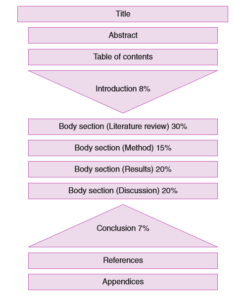
How can We Help you with your Dissertation?
If you are still unsure about how to structure a dissertation or thesis, or simply lack the motivation to kick start your dissertation project, you might be interested in our dissertation services .
If you are still unsure about how to structure a dissertation or thesis, or lack the motivation to kick start your dissertation project, you might be interested in our dissertation services.
Whether you need help with individual chapters, proposals or the full dissertation paper, we have PhD-qualified writers who will write your paper to the highest academic standard. ResearchProspect is UK-based, and a UK-registered business, which means the UK consumer law protects all our clients.
All You Need to Know About Us Learn More About Our Dissertation Services
FAQs About Structure a Dissertation
What does the title page of a dissertation contain.
The title page will contain details of the author/researcher, research topic , degree program (the paper is to be submitted for) and research supervisor’s name(s). The name of your university, logo, student number and submission date can also be presented on the title page.
What is the purpose of adding acknowledgement?
The acknowledgements section allows you to thank those who helped you with your dissertation project. You might want to mention the names of your academic supervisor, family members, friends, God and participants of your study whose contribution and support enabled you to complete your work.
Can I omit the glossary from the dissertation?
Yes, but only if you think that your paper does not contain any terms or phrases that the reader might not understand. If you think you have used them in the paper, you must create a glossary that lists important phrases and terms with their meanings explained.
What is the purpose of appendices in a dissertation?
Any information that is not directly relevant to research questions or hypotheses but could be useful for the readers can be placed under the Appendices, such as questionnaire that was used in the study.
Which referencing style should I use in my dissertation?
You can use any of the referencing styles such as APA, MLA, and Harvard, according to the recommendation of your university; however, almost all UK institutions prefer Harvard referencing style .
What is the difference between references and bibliography?
References contain all the works that you read up and used and therefore, cited within the text of your thesis. However, in case you read on some works and resources that you didn’t end up citing in-text, they will be referenced in what is called a bibliography.
Additional readings might also be present alongside each bibliography entry for readers.
You May Also Like
Do dissertations scare you? Struggling with writing a flawless dissertation? Well, congratulations, you have landed in the perfect place. In this blog, we will take you through the detailed process of writing a dissertation. Sounds fun? We thought so!
Your dissertation introduction chapter provides detailed information on the research problem, significance of research, and research aim & objectives.
Make sure to develop a conceptual framework before conducting research. Here is all you need to know about what is a conceptual framework is in a dissertation?
As Featured On

USEFUL LINKS
LEARNING RESOURCES

COMPANY DETAILS

Splash Sol LLC
- How It Works

Work With Us
Private Coaching
Done-For-You
Short Courses
Client Reviews
Free Resources
Dissertation Structure & Layout 101

In this post, we’ll be discussing a traditional dissertation/thesis structure and layout, which is generally used for social science research across universities, whether in the US, UK, Europe or Australia. However, some universities may have small variations on this structure (extra chapters, merged chapters, slightly different ordering, etc).
So, always check with your university if they have a prescribed structure or layout that they expect you to work with. If not, it’s safe to assume the structure we’ll discuss here is suitable. And even if they do have a prescribed structure, you’ll still get value from this post as we’ll explain the core contents of each section.
Overview: S tructuring a dissertation or thesis
- Acknowledgements page
- Abstract (or executive summary)
- Table of contents , list of figures and tables
- Chapter 1: Introduction
- Chapter 2: Literature review
- Chapter 3: Methodology
- Chapter 4: Results
- Chapter 5: Discussion
- Chapter 6: Conclusion
- Reference list
As I mentioned, some universities will have slight variations on this structure. For example, they want an additional “personal reflection chapter”, or they might prefer the results and discussion chapter to be merged into one. Regardless, the overarching flow will always be the same, as this flow reflects the research process , which we discussed here – i.e.:
- The introduction chapter presents the core research question and aims .
- The literature review chapter assesses what the current research says about this question.
- The methodology, results and discussion chapters go about undertaking new research about this question.
- The conclusion chapter (attempts to) answer the core research question .
In other words, the dissertation structure and layout reflect the research process of asking a well-defined question(s), investigating, and then answering the question – see below.

To restate that – the structure and layout of a dissertation reflect the flow of the overall research process . This is essential to understand, as each chapter will make a lot more sense if you “get” this concept. If you’re not familiar with the research process, read this post before going further.
Right. Now that we’ve covered the big picture, let’s dive a little deeper into the details of each section and chapter. Oh and by the way, you can also grab our free dissertation/thesis template here to help speed things up.
The title page of your dissertation is the very first impression the marker will get of your work, so it pays to invest some time thinking about your title. But what makes for a good title? A strong title needs to be 3 things:
- Succinct (not overly lengthy or verbose)
- Specific (not vague or ambiguous)
- Representative of the research you’re undertaking (clearly linked to your research questions)
Typically, a good title includes mention of the following:
- The broader area of the research (i.e. the overarching topic)
- The specific focus of your research (i.e. your specific context)
- Indication of research design (e.g. quantitative , qualitative , or mixed methods ).
For example:
A quantitative investigation [research design] into the antecedents of organisational trust [broader area] in the UK retail forex trading market [specific context/area of focus].
Again, some universities may have specific requirements regarding the format and structure of the title, so it’s worth double-checking expectations with your institution (if there’s no mention in the brief or study material).
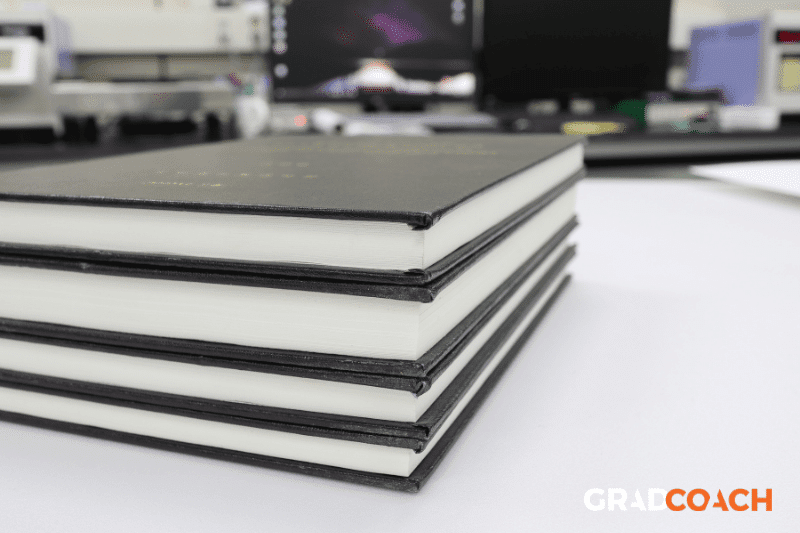
Acknowledgements
This page provides you with an opportunity to say thank you to those who helped you along your research journey. Generally, it’s optional (and won’t count towards your marks), but it is academic best practice to include this.
So, who do you say thanks to? Well, there’s no prescribed requirements, but it’s common to mention the following people:
- Your dissertation supervisor or committee.
- Any professors, lecturers or academics that helped you understand the topic or methodologies.
- Any tutors, mentors or advisors.
- Your family and friends, especially spouse (for adult learners studying part-time).
There’s no need for lengthy rambling. Just state who you’re thankful to and for what (e.g. thank you to my supervisor, John Doe, for his endless patience and attentiveness) – be sincere. In terms of length, you should keep this to a page or less.
Abstract or executive summary
The dissertation abstract (or executive summary for some degrees) serves to provide the first-time reader (and marker or moderator) with a big-picture view of your research project. It should give them an understanding of the key insights and findings from the research, without them needing to read the rest of the report – in other words, it should be able to stand alone .
For it to stand alone, your abstract should cover the following key points (at a minimum):
- Your research questions and aims – what key question(s) did your research aim to answer?
- Your methodology – how did you go about investigating the topic and finding answers to your research question(s)?
- Your findings – following your own research, what did do you discover?
- Your conclusions – based on your findings, what conclusions did you draw? What answers did you find to your research question(s)?
So, in much the same way the dissertation structure mimics the research process, your abstract or executive summary should reflect the research process, from the initial stage of asking the original question to the final stage of answering that question.
In practical terms, it’s a good idea to write this section up last , once all your core chapters are complete. Otherwise, you’ll end up writing and rewriting this section multiple times (just wasting time). For a step by step guide on how to write a strong executive summary, check out this post .
Need a helping hand?
Table of contents
This section is straightforward. You’ll typically present your table of contents (TOC) first, followed by the two lists – figures and tables. I recommend that you use Microsoft Word’s automatic table of contents generator to generate your TOC. If you’re not familiar with this functionality, the video below explains it simply:
If you find that your table of contents is overly lengthy, consider removing one level of depth. Oftentimes, this can be done without detracting from the usefulness of the TOC.
Right, now that the “admin” sections are out of the way, its time to move on to your core chapters. These chapters are the heart of your dissertation and are where you’ll earn the marks. The first chapter is the introduction chapter – as you would expect, this is the time to introduce your research…
It’s important to understand that even though you’ve provided an overview of your research in your abstract, your introduction needs to be written as if the reader has not read that (remember, the abstract is essentially a standalone document). So, your introduction chapter needs to start from the very beginning, and should address the following questions:
- What will you be investigating (in plain-language, big picture-level)?
- Why is that worth investigating? How is it important to academia or business? How is it sufficiently original?
- What are your research aims and research question(s)? Note that the research questions can sometimes be presented at the end of the literature review (next chapter).
- What is the scope of your study? In other words, what will and won’t you cover ?
- How will you approach your research? In other words, what methodology will you adopt?
- How will you structure your dissertation? What are the core chapters and what will you do in each of them?
These are just the bare basic requirements for your intro chapter. Some universities will want additional bells and whistles in the intro chapter, so be sure to carefully read your brief or consult your research supervisor.
If done right, your introduction chapter will set a clear direction for the rest of your dissertation. Specifically, it will make it clear to the reader (and marker) exactly what you’ll be investigating, why that’s important, and how you’ll be going about the investigation. Conversely, if your introduction chapter leaves a first-time reader wondering what exactly you’ll be researching, you’ve still got some work to do.
Now that you’ve set a clear direction with your introduction chapter, the next step is the literature review . In this section, you will analyse the existing research (typically academic journal articles and high-quality industry publications), with a view to understanding the following questions:
- What does the literature currently say about the topic you’re investigating?
- Is the literature lacking or well established? Is it divided or in disagreement?
- How does your research fit into the bigger picture?
- How does your research contribute something original?
- How does the methodology of previous studies help you develop your own?
Depending on the nature of your study, you may also present a conceptual framework towards the end of your literature review, which you will then test in your actual research.
Again, some universities will want you to focus on some of these areas more than others, some will have additional or fewer requirements, and so on. Therefore, as always, its important to review your brief and/or discuss with your supervisor, so that you know exactly what’s expected of your literature review chapter.

Now that you’ve investigated the current state of knowledge in your literature review chapter and are familiar with the existing key theories, models and frameworks, its time to design your own research. Enter the methodology chapter – the most “science-ey” of the chapters…
In this chapter, you need to address two critical questions:
- Exactly HOW will you carry out your research (i.e. what is your intended research design)?
- Exactly WHY have you chosen to do things this way (i.e. how do you justify your design)?
Remember, the dissertation part of your degree is first and foremost about developing and demonstrating research skills . Therefore, the markers want to see that you know which methods to use, can clearly articulate why you’ve chosen then, and know how to deploy them effectively.
Importantly, this chapter requires detail – don’t hold back on the specifics. State exactly what you’ll be doing, with who, when, for how long, etc. Moreover, for every design choice you make, make sure you justify it.
In practice, you will likely end up coming back to this chapter once you’ve undertaken all your data collection and analysis, and revise it based on changes you made during the analysis phase. This is perfectly fine. Its natural for you to add an additional analysis technique, scrap an old one, etc based on where your data lead you. Of course, I’m talking about small changes here – not a fundamental switch from qualitative to quantitative, which will likely send your supervisor in a spin!
You’ve now collected your data and undertaken your analysis, whether qualitative, quantitative or mixed methods. In this chapter, you’ll present the raw results of your analysis . For example, in the case of a quant study, you’ll present the demographic data, descriptive statistics, inferential statistics , etc.
Typically, Chapter 4 is simply a presentation and description of the data, not a discussion of the meaning of the data. In other words, it’s descriptive, rather than analytical – the meaning is discussed in Chapter 5. However, some universities will want you to combine chapters 4 and 5, so that you both present and interpret the meaning of the data at the same time. Check with your institution what their preference is.
Now that you’ve presented the data analysis results, its time to interpret and analyse them. In other words, its time to discuss what they mean, especially in relation to your research question(s).
What you discuss here will depend largely on your chosen methodology. For example, if you’ve gone the quantitative route, you might discuss the relationships between variables . If you’ve gone the qualitative route, you might discuss key themes and the meanings thereof. It all depends on what your research design choices were.
Most importantly, you need to discuss your results in relation to your research questions and aims, as well as the existing literature. What do the results tell you about your research questions? Are they aligned with the existing research or at odds? If so, why might this be? Dig deep into your findings and explain what the findings suggest, in plain English.
The final chapter – you’ve made it! Now that you’ve discussed your interpretation of the results, its time to bring it back to the beginning with the conclusion chapter . In other words, its time to (attempt to) answer your original research question s (from way back in chapter 1). Clearly state what your conclusions are in terms of your research questions. This might feel a bit repetitive, as you would have touched on this in the previous chapter, but its important to bring the discussion full circle and explicitly state your answer(s) to the research question(s).

Next, you’ll typically discuss the implications of your findings . In other words, you’ve answered your research questions – but what does this mean for the real world (or even for academia)? What should now be done differently, given the new insight you’ve generated?
Lastly, you should discuss the limitations of your research, as well as what this means for future research in the area. No study is perfect, especially not a Masters-level. Discuss the shortcomings of your research. Perhaps your methodology was limited, perhaps your sample size was small or not representative, etc, etc. Don’t be afraid to critique your work – the markers want to see that you can identify the limitations of your work. This is a strength, not a weakness. Be brutal!
This marks the end of your core chapters – woohoo! From here on out, it’s pretty smooth sailing.
The reference list is straightforward. It should contain a list of all resources cited in your dissertation, in the required format, e.g. APA , Harvard, etc.
It’s essential that you use reference management software for your dissertation. Do NOT try handle your referencing manually – its far too error prone. On a reference list of multiple pages, you’re going to make mistake. To this end, I suggest considering either Mendeley or Zotero. Both are free and provide a very straightforward interface to ensure that your referencing is 100% on point. I’ve included a simple how-to video for the Mendeley software (my personal favourite) below:
Some universities may ask you to include a bibliography, as opposed to a reference list. These two things are not the same . A bibliography is similar to a reference list, except that it also includes resources which informed your thinking but were not directly cited in your dissertation. So, double-check your brief and make sure you use the right one.
The very last piece of the puzzle is the appendix or set of appendices. This is where you’ll include any supporting data and evidence. Importantly, supporting is the keyword here.
Your appendices should provide additional “nice to know”, depth-adding information, which is not critical to the core analysis. Appendices should not be used as a way to cut down word count (see this post which covers how to reduce word count ). In other words, don’t place content that is critical to the core analysis here, just to save word count. You will not earn marks on any content in the appendices, so don’t try to play the system!
Time to recap…
And there you have it – the traditional dissertation structure and layout, from A-Z. To recap, the core structure for a dissertation or thesis is (typically) as follows:
- Acknowledgments page
Most importantly, the core chapters should reflect the research process (asking, investigating and answering your research question). Moreover, the research question(s) should form the golden thread throughout your dissertation structure. Everything should revolve around the research questions, and as you’ve seen, they should form both the start point (i.e. introduction chapter) and the endpoint (i.e. conclusion chapter).
I hope this post has provided you with clarity about the traditional dissertation/thesis structure and layout. If you have any questions or comments, please leave a comment below, or feel free to get in touch with us. Also, be sure to check out the rest of the Grad Coach Blog .

You Might Also Like:

How To Choose A Tutor For Your Dissertation
Hiring the right tutor for your dissertation or thesis can make the difference between passing and failing. Here’s what you need to consider.

5 Signs You Need A Dissertation Helper
Discover the 5 signs that suggest you need a dissertation helper to get unstuck, finish your degree and get your life back.

Writing A Dissertation While Working: A How-To Guide
Struggling to balance your dissertation with a full-time job and family? Learn practical strategies to achieve success.

How To Review & Understand Academic Literature Quickly
Learn how to fast-track your literature review by reading with intention and clarity. Dr E and Amy Murdock explain how.

Dissertation Writing Services: Far Worse Than You Think
Thinking about using a dissertation or thesis writing service? You might want to reconsider that move. Here’s what you need to know.
📄 FREE TEMPLATES
Research Topic Ideation
Proposal Writing
Literature Review
Methodology & Analysis
Academic Writing
Referencing & Citing
Apps, Tools & Tricks
The Grad Coach Podcast
36 Comments
many thanks i found it very useful
Glad to hear that, Arun. Good luck writing your dissertation.
Such clear practical logical advice. I very much needed to read this to keep me focused in stead of fretting.. Perfect now ready to start my research!
what about scientific fields like computer or engineering thesis what is the difference in the structure? thank you very much
Thanks so much this helped me a lot!
Very helpful and accessible. What I like most is how practical the advice is along with helpful tools/ links.
Thanks Ade!
Thank you so much sir.. It was really helpful..
You’re welcome!
Hi! How many words maximum should contain the abstract?
Thank you so much 😊 Find this at the right moment
You’re most welcome. Good luck with your dissertation.
best ever benefit i got on right time thank you
Many times Clarity and vision of destination of dissertation is what makes the difference between good ,average and great researchers the same way a great automobile driver is fast with clarity of address and Clear weather conditions .
I guess Great researcher = great ideas + knowledge + great and fast data collection and modeling + great writing + high clarity on all these
You have given immense clarity from start to end.
Morning. Where will I write the definitions of what I’m referring to in my report?
Thank you so much Derek, I was almost lost! Thanks a tonnnn! Have a great day!
Thanks ! so concise and valuable
This was very helpful. Clear and concise. I know exactly what to do now.
Thank you for allowing me to go through briefly. I hope to find time to continue.
Really useful to me. Thanks a thousand times
Very interesting! It will definitely set me and many more for success. highly recommended.
Thank you soo much sir, for the opportunity to express my skills
Usefull, thanks a lot. Really clear
Very nice and easy to understand. Thank you .
That was incredibly useful. Thanks Grad Coach Crew!
My stress level just dropped at least 15 points after watching this. Just starting my thesis for my grad program and I feel a lot more capable now! Thanks for such a clear and helpful video, Emma and the GradCoach team!
Do we need to mention the number of words the dissertation contains in the main document?
It depends on your university’s requirements, so it would be best to check with them 🙂
Such a helpful post to help me get started with structuring my masters dissertation, thank you!
Great video; I appreciate that helpful information
It is so necessary or avital course
This blog is very informative for my research. Thank you
Doctoral students are required to fill out the National Research Council’s Survey of Earned Doctorates
wow this is an amazing gain in my life
This is so good
How can i arrange my specific objectives in my dissertation?
Trackbacks/Pingbacks
- What Is A Literature Review (In A Dissertation Or Thesis) - Grad Coach - […] is to write the actual literature review chapter (this is usually the second chapter in a typical dissertation or…
Submit a Comment Cancel reply
Your email address will not be published. Required fields are marked *
Save my name, email, and website in this browser for the next time I comment.
Submit Comment
- Print Friendly

COMMENTS
A typical thesis structure 1. Abstract. The abstract is the overview of your thesis and generally very short. This section should highlight the main contents of your thesis "at a glance" so that someone who is curious about your work can get the gist quickly.
When writing an abstract, make sure you explicitly mention the crux of your thesis. Also, avoid reiterating what you have mentioned in the title of your document. Body of a Thesis Structure 2. Introduction/preface. The introduction chapter of your thesis outlines its core arguments, hypotheses, and results.
Thesis Structure 1. Title Page. The title page includes essential details about the thesis, such as the title, author's name, program, supervisor, and submission date. Ensure compliance with your institution's formatting guidelines. 2. Abstract. An abstract is a brief overview of the entire thesis, typically 150-300 words.
Your thesis is the central claim in your essay—your main insight or idea about your source or topic.Your thesis should appear early in an academic essay, followed by a logically constructed argument that supports this central claim. A strong thesis is arguable, which means a thoughtful reader could disagree with it and therefore needs your careful analysis of the evidence to understand how ...
The structure of your thesis will depend on the kind of thesis you are writing. In some cases, there are conventional structures that are expected in the discipline. For example, theses that are empirical, experimental, and/or quantitative in nature generally follow the structure: introduction including aims, literature review, methodology ...
If you are still unsure about how to structure a dissertation or thesis, or lack the motivation to kick start your dissertation project, you might be interested in our dissertation services. Whether you need help with individual chapters, proposals or the full dissertation paper, we have PhD-qualified writers who will write your paper to the ...
S o, you've got a decent understanding of what a dissertation is, you've chosen your topic and hopefully you've received approval for your research proposal.Awesome! Now its time to start the actual dissertation or thesis writing journey. To craft a high-quality document, the very first thing you need to understand is dissertation structure.In this post, we'll walk you through the ...
• Return to a broader lens, reminding readers how the thesis applies to your context. • Suggest what the reader should take away from your paper. • Pose questions for future study, actions to take, policy interventions, or other implications of your ideas. Take care not to repeat your words exactly in the conclusion.
The final structure of your thesis depends on a variety of components, such as: Your discipline; Your topic; Your theoretical approach; Humanities theses are often structured more like a longer-form essay. Just like in an essay, you build an argument to support a central thesis. ... Your thesis conclusion should concisely answer your main ...
Dissertation & Thesis Outline | Example & Free Templates. Published on June 7, 2022 by Tegan George.Revised on November 21, 2023. A thesis or dissertation outline is one of the most critical early steps in your writing process.It helps you to lay out and organize your ideas and can provide you with a roadmap for deciding the specifics of your dissertation topic and showcasing its relevance to ...